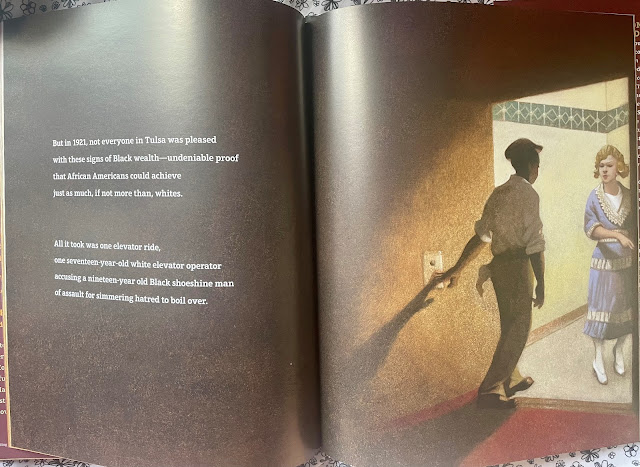Unspeakable: The Tulsa Race Massacre by Carole Boston Weatherford
Weatherford, C. (2021). Unspeakable: The Tulsa Race Massacre (F. Cooper, Illus.) Carolrhoda Books.
This book covers the Tulsa Race
Massacre of 1921, a topic that has only recently begun to be discussed among
the general public. Written by Carole Boston Weatherford, an author known for
writing about Black history in America, this book uses a narrative writing style
to explain what this area was like before the massacre and how the massacre took
place. There is a repetition of the phrase “Once upon a time…” inviting the
reader to revel in the prosperous community of Greenwood when it was known as
the “Black Wall Street.” Weatherford is able to seamlessly list all the ways in
which Greenwood was almost magical, being a place where the Black community was
striving and achieving more than the white community across the tracks at a
time when racism and segregation were still prominent. The tone in the first
half is meant to invite the reader to build a connection and admiration for
this part of Tulsa, making the devastation in the second half have a bigger
impact on the reader. The illustrations help in this goal by giving the images
in the first half warm dreamlike tones as if they were photographs from the time.
Directly in the middle is a spread that signals the change with two thirds of
it in shadow forcing you to focus on the words stated and the image of the
elevator ride that started it all. The second half of the book takes on a
harsher tone with less focus on the background in the illustrations and less
use of the phrase “Once upon a time…” Weatherford states the facts in a nonpartisan
tone not shying away from the horrors that happened while keeping it child appropriate
by keeping the violence out of the images. She does not condescend or simplify
the events, nor does she hide the truth behind them including the hidden plots
and intentions behind the massacre.
To display their authority on the
subject, both the author and illustrator include notes in the background
explaining their personal connections to the event explaining why they felt
they needed to put out this book. This note at some points simply repeats the
information provided within the book but at a deeper level including pictures
to instill accuracy. However, there is no bibliography or mention of further
research though one can assume research was done with the number of specific
facts and dates provided. There is a link provided at the bottom of the spread offering
a discussion guide and further resources, though when you follow it, it is
mainly a page advertising the book with another link to the resource and no additional
references or research resources. This book provides a lesson on a part of history
that is often forgotten but necessary to learn presenting only facts in a way
that evokes emotion on the part of the reader and being respectful towards the
event and the reader.

Comments
Post a Comment